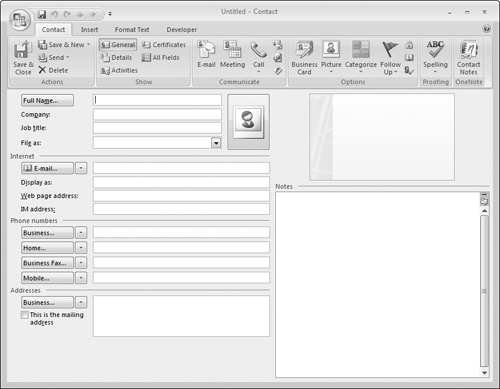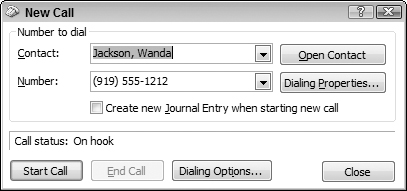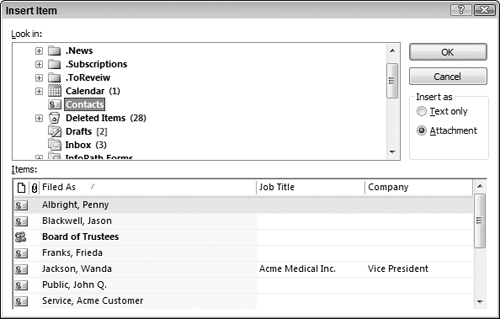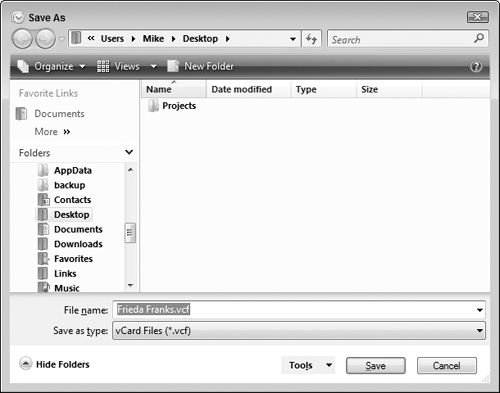More about Contacts
Outlook contacts function as much more than as the contents of a simple address book. This section covers additional details and capabilities of Outlook contacts.
The Contact form
The Contact form, shown in Figure 29-14, provides places for you to enter many different kinds of information about a contact. The only field that is required is the name; you can use all, some, or none of the other fields, as you like. Some of the elements on the Contacts form may deserve an explanation, as provided in the following sections.
Figure 29-14. The Contact form provides fields for a wide variety of information about the contact.

Full Name
You can simply enter a contact’s name in the Full Name field in the usual way, for example John. Q. Public. You can also click the adjacent Full Name button to bring up the Check Full Name dialog box, shown in Figure 29-15. Here you can specify a title such as Dr. or Mrs. and a suffix such as Jr. or Sr.
Figure 29-15. The Check Full Name dialog box lets you enter more details for a contact’s name.

Note the option in this dialog box: Show This Again When Name Is Incomplete or Unclear. When this option is on (the default), Outlook opens this dialog box automatically when you enter an incomplete name such as “Fred” in the Full Name field.
The File As field determines how a contact will be filed in the address book. The default is last name first (Public, John Q.) but you can also choose to file a contact first name first.
Phone Numbers
The Phone Numbers section of the contacts form provides spaces for four numbers. By default, these are labeled as Business, Home, Business Fax, and Mobile, but you can change which numbers are displayed in a particular Phone Number field by clicking the adjacent down arrow and selecting from the list. Some of the choices available are Home Fax, Pager, and Assistant. Outlook saves a phone number for each designation, but only four numbers are displayed on the Contacts form at one time. When you open the list of designations, those for which you have entered a phone number are checked.
Quick E-MailWhen a contact is open, click the E-Mail button on the Ribbon to create a new e-mail message addressed to the contact. |
Next to each Phone Number field is a button with the field’s designation on it. If you click one of these buttons, Outlook opens the Check Phone Number dialog box, shown in Figure 29-16. Here you can enter additional details for the phone number if desired.
Figure 29-16. The Check Phone Number dialog box lets you enter more details for a contact’s phone number.

Addresses
The Addresses section of the contacts form can store up to three addresses designated as Home, Business, and Other. Select the one to display by clicking the down arrow adjacent to the address box. Click the adjacent button to open the Check Address dialog box (Figure 29-17), in which you can enter or edit address details. By default, Outlook displays this dialog box automatically if you enter an address that appears to be incomplete or unclear.
Figure 29-17. The Check Address dialog box lets you enter more details for a contact’s address.

One of the addresses for a contact can be designated as the mailing address by selecting the corresponding option. Outlook uses this address when you are doing a mail merge using Outlook contact data. Mail merge is discussed later in this chapter.
Picture
You can associate a picture with a contact by clicking the Picture button on the contacts form. Outlook displays a dialog box that lets you browse for the picture file. When you have associated a picture with a contact, it displays on the picture button and on the contact’s business card, as shown in Figure 29-18. To remove or change the picture, right-click it and choose from the context menu.
E-mail addresses
Outlook can store as many as three e-mail addresses for a contact, designated as E-Mail, E-Mail 2, and E-Mail 3. You select which one to display on the contacts form using the arrow adjacent to the E-Mail field.
If you create an e-mail message to a contact by clicking the E-mail button on the Ribbon on a contact form, Outlook creates a message addressed to all the e-mail addresses for that contact. If you click the To button on an e-mail message, the list of contacts displays each e-mail separately, and you can choose the one to use.
The Display As field determines how the contact is displayed in a message’s To or Cc field. By default, Outlook displays the contact’s name followed by the e-mail address in parentheses, but you can edit this to display as desired—for example, just the person’s name.
Notes
The Notes section on a contact form is for entry of any arbitrary information that you want to save with the contact. Simply click in the box and enter or edit as usual. You can use the tools on the Format Text Ribbon to apply formatting to the Notes text, if desired.
Other contact displays
The default contact display, called General, has been shown in the figures throughout this chapter so far. This is the display that you will probably use most often. Several other displays, or views, are available; you select the display to view from the Show section of the Contact Ribbon.
Details
The Details view gives you access to secondary information about a contact. This view is shown in Figure 29-19. This information includes fields such as Department, Office, Nickname, and Spouse/Partner as well as details for the person’s NetMeeting settings. You may never use this view, but it’s available if you need it.
Certificates
One of the security features available in Outlook is digital certificates. A contact can send you a certificate, and you can then use this certificate to send encrypted mail to that person. The Certificates display lets you view and work with the certificate(s) that you have for a contact. Digital certificates are covered in Chapter 28.
All Fields
The All Fields display lets you view all or selected subsets of the data associated with a contact. The amount of information—number of fields—that an individual contact can hold is quite impressive and is way too much to display fully in any other contact view. The All Fields display also lets you define your own custom fields for a contact and to change the properties of some fields.
The All Fields display is shown in Figure 29-20. Near the top is the Select From list, in which you choose which fields to display in the window. You can display all fields as well as one of several defined subsets, such as All Contact Fields or All Mail Fields.
Some fields can be edited in this view by clicking in the Value column and making the desired changes. Other fields are generated internally by Outlook and cannot be edited.
You can add a custom field to the contact by clicking the New button at the bottom of the window. Outlook displays the New Field dialog box (Figure 29-21), in which you enter a name for the field (which cannot duplicate an existing field name). You also select the data type for the field. Your choices are Text, Number, Percent, Currency, Yes/No, and Date/Time. For certain data types, you can also select a format from the Format list. When you are finished, click OK and the custom field will be added to the All Fields display.
Figure 29-21. Defining a new field for a contact.

You can change the properties of a field by clicking it in the list and then clicking the Properties button. This is relevant only for user-defined fields; the properties of Outlook’s built-in fields are locked.
Editing the business card
Outlook creates a business card for each contact based on a default template. As you can see in Figure 29-22, this template includes name, company, title, phone numbers, e-mail and postal addresses, and a photo (assuming that these elements are part of the contact).
Figure 29-22. The default business card template includes the information needed most often.

To edit the business card for a contact, click the Business Card button on the Contact tab of the Ribbon. Outlook opens the Edit Business Card dialog box, shown in Figure 29-23.
The top-left section of this dialog box previews how the business card will look with your edits. The top-right section defines the overall layout of the card:
Layout: Specifies the image location. You can also omit the image or use it as the card background.
Background: Lets you select a background color for the card.
Image: Lets you specify a different image when you click the Change button.
Image Area: Determines how much of the card is occupied by the image. The maximum is 50 percent.
Image Align: Determines how the image is positioned within the image area.
The lower-left section of the Edit Business Card dialog box lets you specify the data fields that are included on the card and their order. You can do the following:
Click Add and then select from the menu to add a field to the card.
Click Remove to remove the selected field from the card.
Click the up or down arrow to change the position of the selected field.
The lower-right section of this dialog box is for text formatting. When a field is selected in the Fields list, use the tools here to do the following:
Increase or decrease font size
Make font bold, italic, or underlined
Align text left, center, or right
Change font color
Oddly enough, you cannot change the font used on a business card; you can change only its size.
The Label section lets you add a label to any data field. You can specify the text of the label, its color, and whether it is displayed to the left or right of the item.
Click the Reset Card button to undo any edits you have made and return the card to the default appearance. Click OK to save your changes and close the dialog box.
Dialing the phone
If your computer is equipped with a modem, you can have Outlook dial the phone for you based on the number associated with a contact. Then you can pick up your handset and complete the call as usual. You must have the modem and handset on the same line, which can be inconvenient if you use the modem to access the Internet. If your Internet connection is via cable modem or DSL, or via a second telephone line, you may want to dedicate an old modem as a dedicated dialer on your voice line. The speed of the modem is not relevant in this application.
When a contact is open, click the arrow on the Call button on the Contact tab to display the menu shown in Figure 29-24. This menu lists all the phone numbers for the current contact. Select the one to dial, and Outlook opens the New Call dialog box (Figure 29-25) with the selected phone number entered. The settings and commands in this dialog box are as follows:
Dialing Properties: Opens the Dialing Properties dialog box, in which you define rules for dialing from your computer. You should not have to change these because they will have been set up when you installed and configured your modem.
Create Journal Entry: Creates an Outlook Journal entry for the call, noting the number called and the time and date of the call.
Dialing Options: Lets you set speed dialer options and add names and numbers to the Speed Dial list.
Start Call: Dials the number.
End Call: Hangs up.
Figure 29-25. The New Call dialog box.

The Call menu has several other commands, as follows:
Redial: Dials a recently called number
Speed Dial: Dials a number on your speed dial list
New Call: Opens the New Call dialog box without any phone number entered
Outlook can also make Instant Messenger calls. If you have specified an Instant Messenger address for the contact, this option appears on the Call menu.
Sending contact information by e-mail
Sending contact information attached to an e-mail message can be very useful. Doing so lets recipients enter the information in their address book quickly and without errors. If you keep an entry for yourself in your address book, you can easily send your own information as well.
Sending contact information in Outlook format
Outlook offers two formats for sending contact information. Outlook’s native format is to send the information as an Outlook item. You can send individual contacts and distribution lists this way. Information sent this way can be used by other Outlook users and possibly by users of other e-mail programs that support this format. To send contact information as an Outlook item, follow these steps:
1. | Create and address the e-mail message as usual. |
2. | On the Insert tab of the Ribbon, click the Insert Item button. Outlook displays the Insert Item dialog box (Figure 29-26). |
3. | In the Look In list at the top of the dialog box, click the Contacts folder. |
4. | In the Items list at the bottom of the dialog box, click the contact or Distribution List to send. Hold down the Ctrl key while clicking to select more than one contact. |
5. | Make sure that the Attachment option is selected. If you select the Text Only option, the information is added to the body of the message but the recipient will not be able to automatically add it to his or her address book. |
6. | Click OK. The item, with a small business card icon, is added to the message’s attachment list. |
Sending contact information in vCard Format
The second format for sending contact information is vCard, a widely supported format for contact information. Most e-mail programs support this format, and you may want to use it when you are not sure that all the intended recipients use an e-mail program that supports Outlook items. You can send only individual contacts, not Distribution lists, using a vCard,. To send a vCard, follow these steps:
1. | Open the contact that you want to send. |
2. | In the Contact window, click the File button and choose Save As from the File menu. Outlook displays the Save As dialog box (Figure 29-27). |
3. | Use the dialog box tools to navigate to the location where you want to save the vCard file. |
4. | In the Save as Type list, select vCard Files (*.vcf). |
5. | The default name for the file is the contact name. You can edit this name if desired. |
6. | Click Save. |
7. | Create an e-mail message and attach the vCard file that you just saved. |
Sending contact information from the Contact form
When you have a contact open, the Actions group of the Contact tab of the Ribbon includes a Send button. You can use this button to send the open contact in one of three ways by selecting the desired command from the associated menu:
Send as Business Card: Outlook creates a new message with the contact inserted in the message body as a business card and attached to the message as a vCard file.
In Internet Format (vCard): Outlook creates a new message with the contact attached to the message as a vCard file.
In Outlook Format: Outlook creates a new message with the contact attached to the message as an Outlook item.
Other contact actions
This section describes some of the other actions you can perform with contacts.
Viewing a map of the contact’s address
If a contact has a valid address entered, you can click the Map button on the Contact tab of the Ribbon to open a Web browser and view a map of the specified location. This feature is powered by the Windows Live Local Web site, which provides other services such as driving directions and business search.
Inviting the contact to a meeting
To invite the contact to a meeting, click the Meeting button on the Contact tab of the Ribbon. Outlook creates a new meeting request addressed to the contact, as shown in Figure 29-28. You can specify the subject and location, enter the date, start and end times, and include a message. You can also add other recipients to the request.
Assigning a task to a contact
To assign a new task to a contact, click the Assign Task button on the Contact ribbon. Outlook opens a task window, as shown in Figure 29-29, in which you can enter details of the task and save it. You learn more about tasks, including assigning an existing task to a contact, in Chapter 30.
Viewing the contact’s Web page
If you have entered a Web page URL for a contact, clicking the Web Page button on the Contact ribbon launches your default Web browser and displays the Web page.
Tagging a contact for follow up
To tag a contact for follow up, click the Follow Up button in the Options section of the Contact ribbon and select the desired follow-up interval from the menu.
Use the Context MenusMany of the actions that you can take with contacts that are described in this section can be accessed without opening the contact. In the Contacts window, simply right-click the contact and choose from the context menu. You can use this technique to send a contact, call a contact, or assign a follow-up of category to a contact. |









